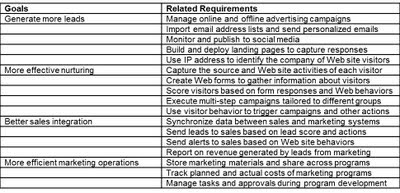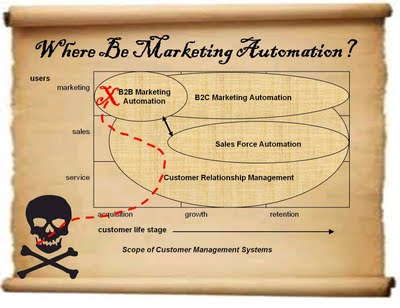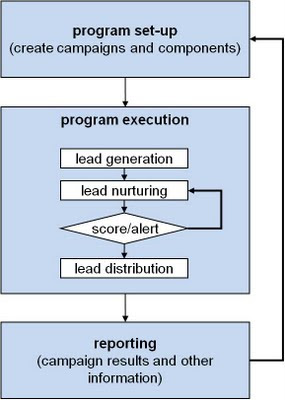I spent most of this week at the inaugural DemandCon conference in San Francisco. My presentation, How to Avoid a Marketing Automation Train Wreck, was based largely on the Marketing Automation Vendor Selection Workbook I released last month (available for free on the RaabGuide Web site). But the heart of the Workbook is a series of checklists like the one below, whereas DemandCon asked presenters to avoid long lists of bullet points. So I had to rethink the format.

After some pondering, I decided it would be more memorable to structure the presentation as a story. This made sense: deploying a marketing automation system is literally a quest, and one that can end in either triumph or the train wreck of my title. Although my actual delivery was marred by a few technical hiccups, I liked the result enough to offer a version of it here.
Prologue
A good adventure begins with a map. This one starts with our hero, a young prince, accidentally uncovering a box containing a map of the marketing technology landscape, showing where B2B marketing automation fits among other types of customer management systems. Since any story is better if you add pirates, this is a treasure map, where X marks the spot. (Sadly, one of the technical hiccups meant the DemandCon audience never saw this image, but I personally find it hilarious. Note the pirate-style headline.):
 The box also holds a chart that lists the features of different types of marketing automation systems. I didn't have time to reformat it, but in the story these are presented as clues to identifying the treasure.
The box also holds a chart that lists the features of different types of marketing automation systems. I didn't have time to reformat it, but in the story these are presented as clues to identifying the treasure.
He also finds a set of puzzle pieces that, when assembled, present a flow chart of standard B2B marketing tasks: program setup, lead generation, nurturing, scoring, transfer to sales, and reporting. This teaches him that marketing automation is a process, not a technology.

Our Story Begins...
The young prince is intrigued by his discovery, but reluctant to take on the quest. He is moved to action by a village of marketers and salespeople crying out for more leads and better nurturing. Specific benefits include replacing point solutions with an integrated system; running larger numbers and more types of marketing programs; less reliance on non-marketing resources to manage Web content and process data; and closer integration with sales. Who could resist?
After the hero announces his decision, he is warned about the perils ahead by a wise old consultant. These include:
- buying without concrete objectives
- choosing systems based on who has the most, best, or coolest features
- only considering industry leaders
- not using scenarios to test systems against your needs
- ignoring the information you can gather from references
- not investing in training, planning, program design, content, and other resources for successful deployment
Thus forewarned, our hero starts his quest. He starts by making a plan, which means he identifies the business benefits expected from this project. These should be quantified and linked to marketing programs that will deliver them. Then he defines the requirements implied by these programs, by listing the tasks to be completed for each project and the system features needed to execute these tasks. I represented requirements as a kitten who “requires” a bowl of milk – except that now it’s a pirate kitten (my second-favorite slide in the deck. Yes, I am easily amused.)

Planning complete, the hero sets out on his search. Along the way, he meets several companions with different traits. Recognizing that he can't succeed alone, he knows he must choose one of them to help him find the treasure. His task at this stage is choosing the right one. (We somehow seem to have lost the pirates. Pity.)
These companions represent the different marketing automation systems. To choose wisely, the hero must understand the type of product he needs. I divide the B2B marketing automation world into three segments: systems serving “micro-businesses” (very small firms where marketing is a part-time job, often for the owner); small to mid-size business (a separate marketing department but typically in one location and serving one product line); and enterprises (huge companies with dozens of marketers serving multiple markets and products). Each type of business has different requirements and is served by different vendors: I won’t list the details here but they’re in the Workbook.
The Journey
Our band of travelers now faces a series of challenges, escaping from traps, crossing rivers, and beating off attacks by wild animals. At each stage a different member demonstrates his special skills. In concrete terms, this means defining scenarios based on the goals you have set for your marketing automation system. What matters is seeing how well the systems perform the tasks you need, not the ones the vendor likes to demonstrate. This means the real challenge is understanding your requirements – our hero must learn about himself before he can complete his quest. It’s a cliché but how else can I sell this to Disney?
Now the scene switches: it’s the tavern after a day of adventures, and our little group are warily eating together, trying to decide who they can trust. In other words, they’re checking references. You’ll remember that skipping references is one of the dangers I warned against. It’s true that the company will hand-pick happy customers, but you can still learn a lot if you ask the right questions:
- why did they pick the system (maybe the cared about something that’s not important to you);
- what do they see as strengths and weaknesses;
- are they using the system the same way you expect to;
- are their skills and resources similar to yours.
If a vendor can’t connect you with a reference whose situation matches your own, be very cautious.

And while we’re on the subject – don’t think social media queries replace reference checking. What comes back is typically a “yes, we love it” from highly motivated fans. Apart from dedicated grudge-holders, few businesspeople will volunteer negative feedback in social media: they can only get in trouble and there’s nothing in it for them. If you do rely on the social media, contact the people who respond and have an in-depth conversation asking the same questions you would ask the vendor’s own references.
Back to our story. The hero still hasn’t chosen on a single companion, and now the group faces the final test: it must cross the desert, storm the castle, and find the treasure. Who will stay and who will run away? Who will is a good long-term partner? The only way to find out is to move ahead.
In marketing automation terms, this means setting up a trial so you can understand the day-to-day details of working with a system. Most vendors will give you a trial license if they know you’re seriously considering their product. The trick to an effective trial is to test the system thoroughly: this means setting up programs are as demanding as those you’ll actually run once you own it and then running them from start to finish.
Here’s where all that early planning and goal-setting comes in handy, since you’ll have defined those programs already. If that sounds like too much work, bear in mind that you’ll need those programs after deployment anyway. So you might as well do the work a bit sooner and have the programs available to help make the right selection.
Triumph and Return
The group now wins the final battle and finds the treasure, only to meet a new crisis: there’s only enough water for two people to recross the desert. The hero must finally choose. In our story, this is easy because everyone else has failed or died nobly – oh, and it turns out that the remaining companion is really a disguised princess, with whom the hero has fallen in love. Didn’t see that coming, did you? Even better, she’s a pirate princess. Disney’s gonna love it.

But the real world isn’t a fairy tale. You may actually find several qualified vendors. Do what you can to make a rational choice – the Workbook provides a list of criteria to consider. But even if there is no clear winner, make a choice and get on with it. Remember your real goal is to get value from using the system, not to run the world’s finest selection project.
Epilogue
The story doesn’t end with the hero’s triumphant return. Treasure is only valuable if you spend it wisely; relationships don’t end with the wedding. It’s hard work to live happily ever after. So we have an epilogue showing how the happy couple used their riches to improve the lives of the villagers for years to come.
In marketing automation terms, this means avoiding the final mistake of underinvesting in deployment. Be prepared to spend money training your staff, developing content, cleansing data, and measuring results. Expect to spend time on organizational changes and coordinating with sales, finance, and IT departments. Hire consultants and agencies if you don’t have the necessary skills in-house – which few firms do when they start. And don’t get stuck in a rut: make a long-term plan to steadily expand use of your system after your initial deployment.
The End
I have to admit this isn’t exactly what I presented at DemandCon, although I wish it had been. The one thing I’d still want to change is to give more emphasis to the section on deployment. It’s problems with process, content, data quality and staffing that cause most marketing automation train wrecks, not the technology.
Do I smell a sequel?


3 comments:
Not only do we require a sequel, but I will personally provide an appropriate eye patch and a parrot if you present it this way!
Great job, David. Thank you.
Be careful what you wish....
Garrrrr - we love Pirate stories:)
Two comments:
1) I love your point about using the trial to run a meaningful pilot - we call it defining a 'trial experiment'. You won't get time to run every experiment under the sun, but you should exercise the system enough to know if you could/would use it and that the way it reports on results would help you make meaningful decisions. [for folks with hyper long sales cycles, it's unlikely you'll see real revenue results in a trial]
2) Seriously, HubSpotters love pirates: see reference to pirate cat whose eyepatch you sadly cannot see - this one-eye kitty belongs to one of our QA leads:) http://hugs.web2.hubspot.com/hugs-2011/
Cheers,
Kirsten
Post a Comment